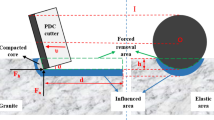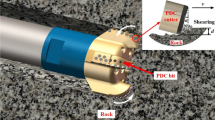Abstract
Polycrystalline diamond compact (PDC) bits are currently the most widely used bits in the petroleum industry. However, the rock-breaking mechanisms of PDC bits are not well understood, especially in deep hard-rock drilling. By modifying the Nishimatsu model, a single PDC cutter force model based on in situ stress is developed in this study. By coupling the mechanical properties of rock and the technological measures of rock breaking, the model can accurately solve the cutting force and assess the rock drillability when applied to a PDC bit. The analysis of research findings shows that the vertical stress initially has a greater impact on the cutting force despite a larger horizontal stress relative to the vertical stress. Moreover, the optimal cutting angle of a PDC cutter is between 15° and 20°. The applicable conditions of the model are obtained experimentally. The model can predict cutting forces in non-expansive rocks well with 2% error. Furthermore, the mechanical-specific energy under low confining pressure has been theoretically demonstrated to increase more quickly than that under high confining pressure. The proposed model can analyse the influence of effective horizontal and vertical stresses and rock strength on the cutting force, which can lead to a better understanding of the rock-breaking mechanisms of PDC drill bits. The results of this work can be used to study PDC bit performance and provide guidelines for the application and design of PDC bits for specific rocks.














Similar content being viewed by others
Abbreviations
- FR * :
-
The force provided by the cutter to rock
- F f :
-
The friction force between cutter and rock in cutting process
- FR :
-
The cutting force to break rock provided by the cutter
- F :
-
The resultant force on the failure line
- P :
-
The resultant stress per unit length on the failure line
- λ :
-
The distance from any point on the failure line AB to point A
- P 0 :
-
The resultant stress coefficient
- h :
-
The depth of the cut
- α :
-
The angle between the fracture line and the horizontal plane
- n :
-
The coefficient related to the parameters of cutting teeth
- θ :
-
The cutting angle of the PDC cutter
- P L :
-
The maximum of resultant stress P
- τ n0 :
-
The component of maximum resultant stress PL along the failure line
- σ n0 :
-
The component of maximum resultant stress PL vertical to the failure line
- φ :
-
The angle between direction of resultant force PL at point A and the front edge of the PDC cutter
- τ m :
-
The shear strength of rock
- φ k :
-
The friction angle of rock
- F σ :
-
The normal component of the resultant force F on the failure line AB
- F τ :
-
The tangential component of the resultant force F on the failure line AB
- σ v :
-
Overburden load
- P h :
-
Fluid column pressure
- P p :
-
Pore pressure
- σ 1 :
-
The horizontal stress of the bottom hole rock
- σ 3 :
-
The vertical stress of the bottom hole rock
- α c :
-
The angle of inclination
- μ :
-
Poisson’s ratio of rocks
- α*:
-
The horizontal structural coefficients
- R :
-
The average cutting stress per unit area
- P σ :
-
The average internal force per unit area of the oblique section whose angle with the horizontal plane is also α
- R 1 :
-
The cutting stress per unit area contributed to overcome the effective horizontal stress σ1
- R 2 :
-
The cutting stress per unit area contributed to overcome the rock shear strength
- R 3 :
-
The cutting stress per unit area contributed to overcome the effective vertical stress σ3
- ξ :
-
The wear coefficient of the cutter
- r :
-
The radius of the PDC cutter
- S FD :
-
The areas of the fracture surface
- S ADB :
-
The contact surface between the cutter and rock
- FR 1 :
-
The cutting force contributed to overcome the effective horizontal stress
- FR 2 :
-
The cutting force contributed to overcome the rock shear intensity
- FR 3 :
-
The cutting force contributed to overcome the effective vertical stress
References
Aldrich JRMJ, Lane KS (1969) Pore pressure effects on Berea sandstone subjected to experimental deformation. Geol Soc Am Bull 80(8):1577–1586
Bellin F, Dourfaye A, King W, Thigpen M (2010) The current state of PDC bit technology. World Oil 231(9):41–46
Bruton G, Crockett R, Taylor M, DenBoer D, Lundm J, Fleming C, Ford R, Garcia G, White A (2014) PDC bit technology for the 21st century. Oilfield Rev 26(2):48–57
Che D, Han P, Guo P, Ehmann K (2012a) Issues in polycrystalline diamond compact cutter-rock interaction from a metal machining point of view-part I: temperature, stresses, and forces. J Manuf Sci Eng 134(6):114–122
Che D, Han P, Guo P, Ehmann K (2012b) Issues in polycrystalline diamond compact cutter–rock interaction from a metal machining point of view—part II: bit performance and rock cutting mechanics. J Manuf Sci Eng 134(6):064002–064014
Che D, Ehmann K, Cao J (2015a) Analytical modeling of heat transfer in polycrystalline diamond compact cutters in rock turning processes. J Manuf Sci Eng 137(3):031005
Che D, Smith J, Ehmann K F (2015) Finite element study of the cutting mechanics of the three dimensional rock turning process. In: ASME 2015 international manufacturing science and engineering conference. American Society of Mechanical Engineers. https://doi.org/10.1115/MSEC20159249
Detournay E, Atkinson C (2000) Influence of pore pressure on the drilling response in low-permeability shear-dilatant rocks. Int J Rock Mech Min Sci 37(7):1091–1101
Fjçr E, Nes OM (2013) Strength anisotropy of Mancos shale. In: 47th US rock mechanics/geomechanics symposium. American Rock Mechanics Association
Glowka DA (1989a) Use of single-cutter data in the analysis of PDC bit designs: part 1-development of a PDC cutting force model. J Petrol Technol 41(08):797–849
Glowka DA (1989b) Use of single-cutter data in the analysis of pdc bit designs: part 2 development and use of the pdcwear computer code. J Petrol Technol 41(8):850–859
Hareland G, Nygaard R, Yan W, Wise JL (2009) Cutting efficiency of a single PDC cutter on hard rock. J Can Pet Technol 48(6):60–65
Hibbs LE, Flom DG (1978) Diamond compact cutter studies for geothermal bit design. J Press Vessel Technol 100(4):406–416
Hiramatsu Y, Oka Y (1996) Determination of the tensile strength of rock by a compression test of an irregular test piece. Int J Rock Mech Min Sci Geomech Abstr 3(2):89–90
Hoover ER, Middleton JN (1981) Laboratory evaluation of PDC drill bits under high speed and high wear conditions. J Petrol Technol 33(12):2316–2321
Hough CL (1986) The effect of back rake angle on the performance of small-diameter polycrystalline diamond rock bits: ANOVA tests. J Energy Res Technol 108(4):305–309
Jadoun RS (2009) Study on rock-drilling using PDC bits for the prediction of torque and rate of penetration. Int J Manuf Technol Manag 17(4):408–418
Kerr CJ (1988) PDC drill bit design and field application evolution. J Petrol Technol 40(3):327–332
Kuhne IG (1952) Die Wirkungsweise von Rotarymeiseln un anderen drehenden Gesteinsbohrern. Sonderdruck aus der Zeitschrift, Bohrtechnik-Brunnenbau, Sonderdruck
Lin T, Hood M, Cooper GA, Li X (1992) Wear and failure mechanisms of polycrystalline diamond compact bits. Wear 156(1):133–150
Menand S, Gerbaud L, Dourfaye A (2005) PDC bit technology improvements increase efficiency, bit life. Drill Contract 61(2):52–54
Merchant ME (1945) Mechanics of the metal cutting process. I. Orthogonal cutting and a type 2 chip. J Appl Phys 16(5):267–275
Miedema SA (2010) New developments of cutting theories with respect to offshore applications. In: The twentieth international offshore and polar engineering conference. International Society of Offshore and Polar Engineers
Moseley SG, Bohn KP, Goedickemeier M (2009) Core drilling in reinforced concrete using polycrystalline diamond (PCD) cutters: wear and fracture mechanisms. Int J Refract Metal Hard Mater 27(2):394–402
Nishimatsu Y (1972) The mechanics of rock cutting. Int J Rock Mech Min Sci Geomech Abstr 9(2):261–270
Rafatian N, Miska SZ, Ledgerwood LW, Yu M, Ahmed R (2009) Experimental study of MSE of a single PDC cutter under simulated pressurized conditions. In: SPE/IADC drilling conference and exhibition. Society of Petroleum Engineers. https://doi.org/10.2118/119302-MS
Rahmani R, Smith JR, Taleghani AD (2012) Analytical modeling of PDC single cutter-rock interaction under confining pressure. In: 46th US rock mechanics/geomechanics symposium. American Rock Mechanics Association
Richard T, Germay C, Detournay E (2007) A simplified model to explore the root cause of stick–slip vibrations in drilling systems with drag bits. J Sound Vib 305(3):432–456
Robinson LH Jr (1959) Effects of pore and confining pressures on failure characteristics of sedimentary rocks. Pet Trans AIME 216:26–32
Seliami H, Fairhurst C, Deliac E, Delbast, B (1989) The role of in situ rock stresses and mud pressure on the penetration rate of PDC bits. In: ISRM international symposium. International Society for Rock Mechanics and Rock Engineering
Walker B, Evans S, Fielder C, Appl F (1980) Field and laboratory applications of bits with synthetic formed diamond cutters. In: Energy-sources technology conference, New Orleans, LA
Zhang P, Mishra B, Heasley KA (2013) The behavior of Carthage Marble and Terratek Sandstone during high pressure, high temperature compression tests. In: 47th US rock mechanics/geomechanics symposium. American Rock Mechanics Association
Zijsling DH (1987) Single cutter testing: a key for PDC bit development. In: Offshore Europe. Society of Petroleum Engineers. https://doi.org/10.2118/16529-MS
Acknowledgements
The research is financially supported by Natural Science Foundation of China, under Award no. 51774093.
Author information
Authors and Affiliations
Corresponding author
Ethics declarations
Conflict of interest
The authors are aware of the ethical responsibilities and they declare that they have no conflict of interest.
Additional information
Publisher's Note
Springer Nature remains neutral with regard to jurisdictional claims in published maps and institutional affiliations.
Rights and permissions
About this article
Cite this article
Li, W., Ling, X. & Pu, H. Development of a Cutting Force Model for a Single PDC Cutter Based on the Rock Stress State. Rock Mech Rock Eng 53, 185–200 (2020). https://doi.org/10.1007/s00603-019-01893-7
Received:
Accepted:
Published:
Issue Date:
DOI: https://doi.org/10.1007/s00603-019-01893-7




